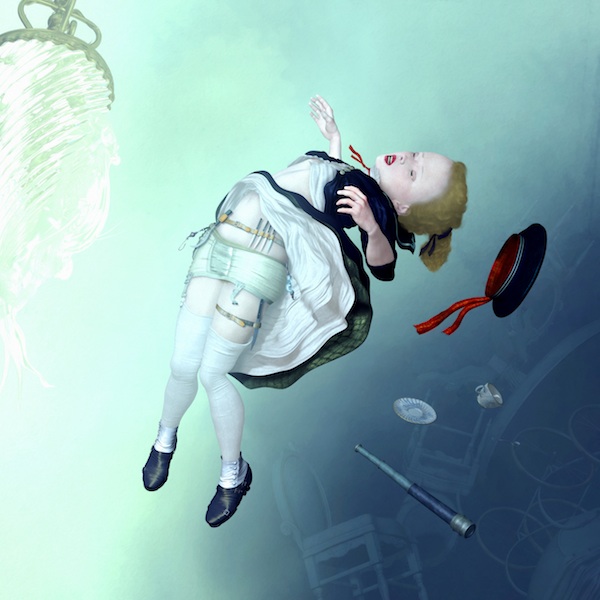
© Ray Caesar, Revelation, Courtesy of Jonathan Levine Gallery, NYC
It had taken months of trying before I met with reclusive artist Ray Caesar just before his opening at New York's Jonathan Levine gallery. Caesar was pleasant and soft-spoken and candidly forthcoming about his troubled past, and the process of healing that his art represented.
Caesar renders art using 3D software with movable appendages operable in a virtual world, sometimes scanning his or his wife Jane's skin from the area below the eyes and eyebrows, giving his creatures a sanguine, sentient appearance. He is their Pygmalion but through their 'autonomous' anatomies they ascend to rulers of their domain. Caesar, whose name connotes emperor, is also the root for caesarean, and according to mythic tradition, Julius Caesar was the first to be delivered in such fashion by a midwife. Childbirth can be viewed as eruptive and emergent, painful but cathartic; the generating host can be consumed by the process. Caesar's art is his progeny but also the instrument of his healing.
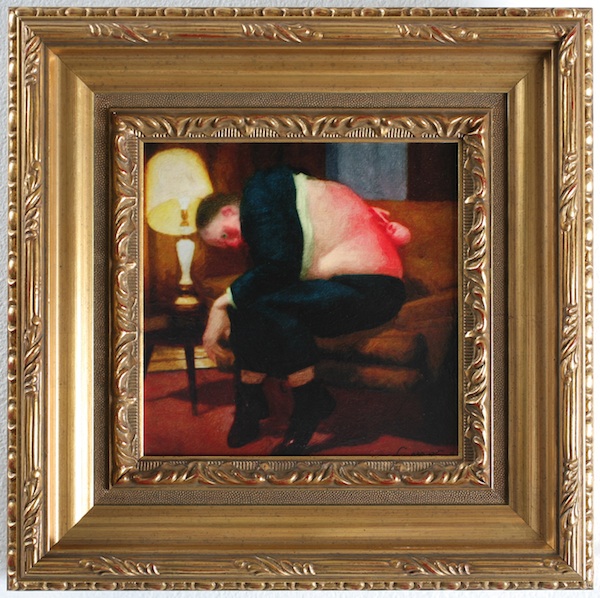
© Ray Caesar, Back Birth, Courtesy of Jonathan Levine Gallery, NYC
A resident of Toronto now, Caesar grew up in a troubled household in the tricky suburbs of South London near Brixton. The tiny wallpapered, Victorian residences from the early 1800s form the nostalgic backgrounds for many of his paintings. "I remember an area behind my father's chairs, where I used to peel the wallpapers away," he recalls.
His artistic influences though are much wider, referencing the French rococo period, the fête galante, Antoine Watteau, Boucher, Fragonard, the period of Dutch paintings - Vermeer, the Regency in England, "all the painters from where you see all the escalation in art," elaborates Casear, "like early American paintings; and fashion from the 1950s and 1960s; when I was growing up that was what people were wearing."
I had suspected a Japanese inspiration behind his work, and he explained that when he was fifteen his future father-in-law, survivor of seven years of prison camp in Siberia, had introduced him to the works of Yukio Mishima and Jun'ichiro Tanizaki, writers that touched upon bushido, the samurai ethic, balancing the cultivation of beauty with discipline.
Caesar also cites writers Anita Brookner, Jane Austen as influences, telling me he had read Harper Lee's To Kill a Mocking Bird countless times. Recently he had been clinically diagnosed with disassociative identity disorder, and therapy had revealed the greater impact of Lee's book.
"The whole realm of To Kill a Mocking Bird started to play out in my mind as ways I would disassociate parts of myself," says Caesar. "The children were one part, the perfect father was Atticus Finch, the grown up man who had no voice was Boo. All these characters played out in my work. For many years for me, there was no voice. Art was the light speaking about the troubles that I was dealing with. Two children see the world as they have never seen before, the world of hate."
Caesar used to like playing with dolls, something that infuriated his father, and though he was left alone to draw, he repressed that side of himself that wished to be more vocal. Later in life, he would work for seventeen years in a children's hospital, and the physical wounds he would witness that were inflicted on the children and their powerlessness to protect themselves, would have a profound effect on his own expression.
I tell him that having access to multiple personalities could be considered more a gift than a disorder. "It actually has been a gift," says Casear, "as a child it was an excellent way of dealing with things, if you were in a situation and you didn't like it, you could close your eyes, go off into somewhere else, and say, for now logic and reason makes no sense to have it... I'm in an insane situation, so I will disassociate myself from logic and reason. I will just accept the world is insane. It is a safety."
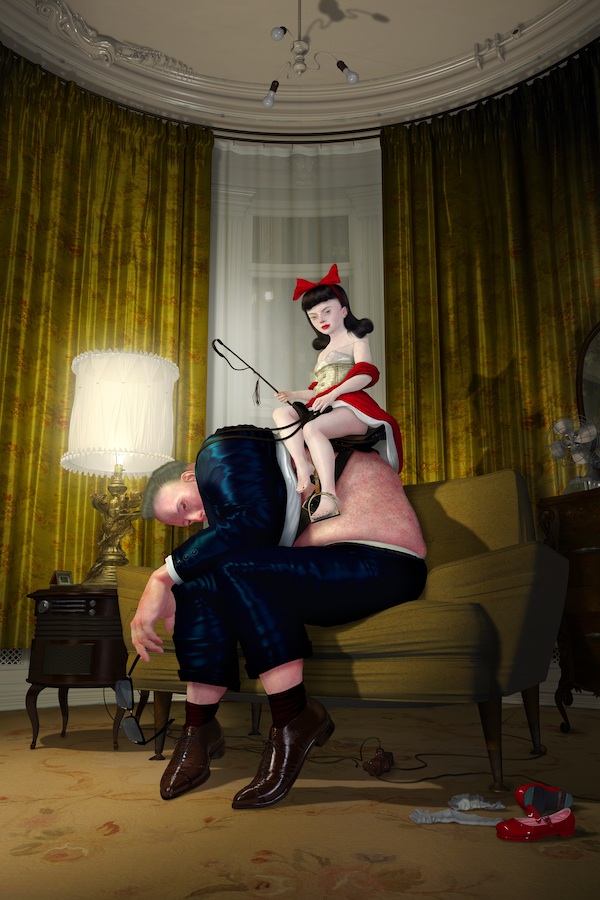
Ray Caesar, Back Birth - Side Saddle, Courtesy of Jonathan Levine Gallery
Because of his frequent anxiety attacks Caesar had undergone therapy, which helped him unravel elements of his personality affected by his childhood upbringing. He tells me, "One disassociative part of myself is the part that is allowed to say, No."
"As a child I used to stand in line-ups with my father who used to scream at people, and I had so much anxiety over that I could either live with the anxiety as a child or disassociate from myself. [If I was at a] super-market with my dad, and he was screaming, I would take that part of myself and tuck it away. And soon as I did it once, I did it over and over again, until later on in life there are all these disassociative parts of oneself."
Logic and reason became personified into Castro and Pollux, "two northern uncles." Castro and Pollux, also known as the Dioscuri, are seen sometimes as St. Elmo's Fire by sailors, and are the patron saints of lost ships at sea. Pollux means polluted, and Castor means clean, reflecting the two conflicting sides of himself; the tattoos of one are mirrored in the scars of the other. Caesar uses many nautical references in his work that allude to suspension, being cast out at sea, falling, birthing, and like the archetype of the Hanged Man, an intermediate state of being.
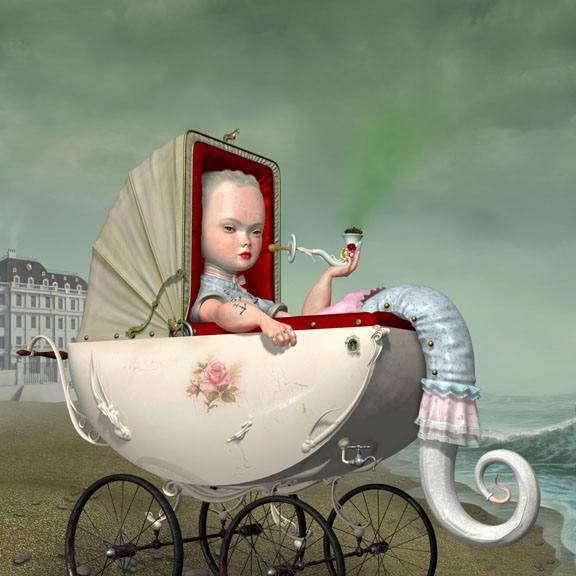
© Ray Caesar, Castor, 2005, Courtesy of Jonathan Levine Gallery, NYC

Pollux, 2005, © Ray Caesar, Courtesy of Jonathan Levine Gallery, NYC
KL: I imagine there was a spiritual aspect to these 'guardians' that therapy may have discounted. Sometimes life itself is a barrier to connecting to other worlds - and maybe a bridge is only possible through the subconscious, which is also the source of our creativity.
RC: I believe so; I had a lot of therapy for it... But when I questioned them, they did say once, that both [points of view] could be right. I think ...that life is not a closed sphere. There is an opening like the top of a cup. And these voices are a part of you and a part of something else, and you become aware of the difference between 'lower entities' and the 'higher entities'. There is a hierarchy in everybody.
We all have panic, depression, anxiety, its just called a disorder when we have too much of it. Disassociation is a human skill. We can walk into a situation and you can say I am not going to be angry, I'm going to put my anger away, just as a child I did it too much, and forgot that I was doing it.
KL: The rooms look inhabited in your paintings.
RC: The rooms exist in a virtual world. Just like each of us carry memories whether of this life or beyond or of another world. There are drawers in cabinets in which I place letters. I lost my mother and sister years ago, and so I have lockets with their pictures in them and it means something to me that they are there, even though you can't see it in the picture all the time.
KL: You used to bury things in the garden when you were a boy.
RC: There was an obsession with doing this. And I didn't realize until I took therapy that's what I was doing with parts of my personality. Burying them, putting them there, so they are safe, so nothing could touch them.
KL: Maybe burning is cathartic? It exorcises the things lodged in your head.
RC: Certainly, if this was causing me a lot of trouble or stress. There was an incident while I was working in the children's hospital, in which I saw a picture of a child who was murdered. And I couldn't get that out of my head. Actually after I saw that particular picture I quit the hospital maybe 3 weeks later; I was really coming apart.
I started drawing a lot of pictures of it, and started tucking it away and burning them. Things were safe if they were burned because no one could touch them again. Years later I did a piece called Bride, it was of a girl who lost her head and I decided to sew it back on. The young murder victim that I saw in the hospital had something to do with that image. She was strangled; her neck was crushed to a point where it was all caved in.
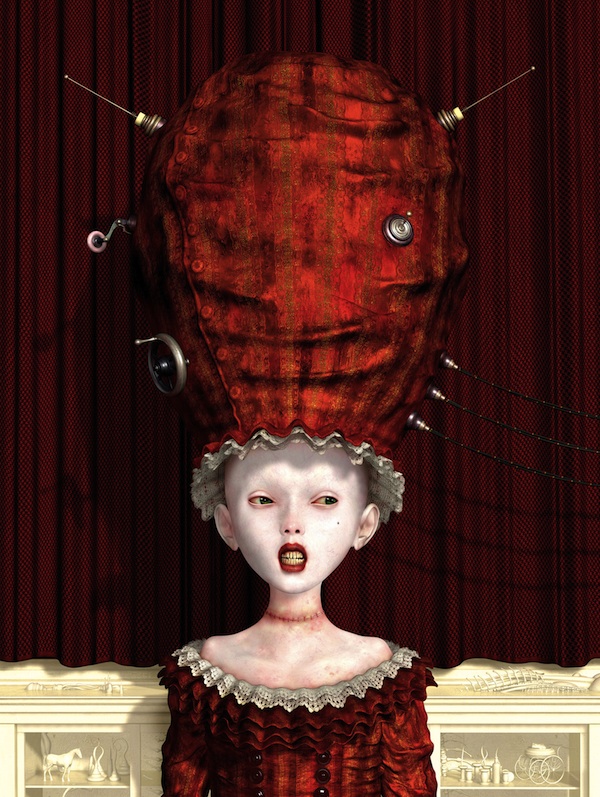
© Ray Caesar, Bride, Courtesy of Jonathan Levine Gallery, NYC
KL: Does it bring it all back - when you look at these pictures again of her you've created?
RC: I have tried to create a place where she is put back together, where she is safe.
KL: She has power now and she's come back with a vengeance. She's got teeth.
RC: Exactly, no one can do that to her again. Your subconscious tries to deal with that. We call them disorders but they are natural ways for the mind to protect itself.
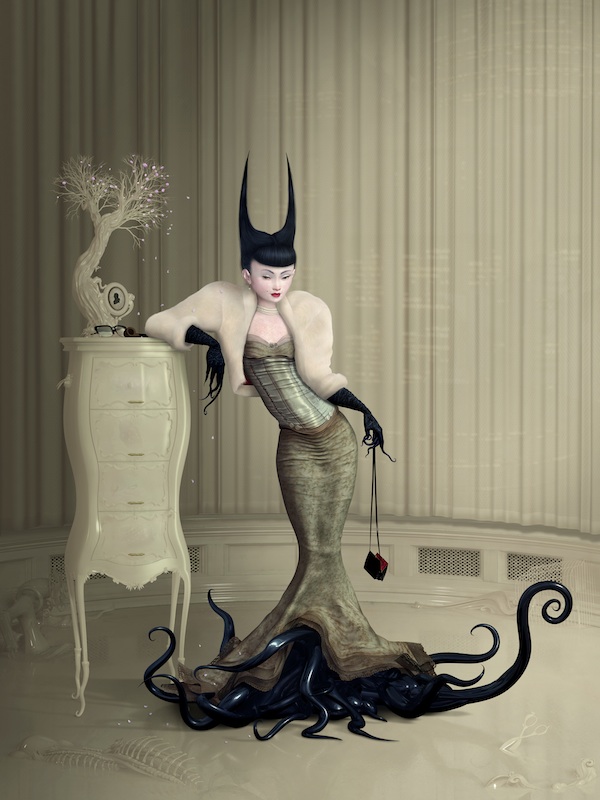
Ray Caesar, Silent Partner digital media on panel (UltraChrome print on Epson Luster paper, mounted on Dibond), framed Edition of 20, Courtesy of Jonathan Levine Gallery, NYC
Ray Caesar's virtual dioramas are populated by a coterie of doll-like creatures. Caesar tells me he has maybe ten or twelve character studies with twenty variations of faces that he resuses, sometimes altering their facial expression by changing the shapes of their noses, morphing smiles with frowns, but he says that somehow, they always return to a look of serenity. Recently he is using more painterly backgrounds and the final digital prints are varnished, giving the illusion of a painted surface that enhances their dream-like milieus. Often things are hidden from view in the finished artworks: if we looked inside the mouths of his creations, they would have teeth and tongues. In Silent Partner, the dismembered parts of a body are concealed within drawers, representing his hidden disassociated selves.
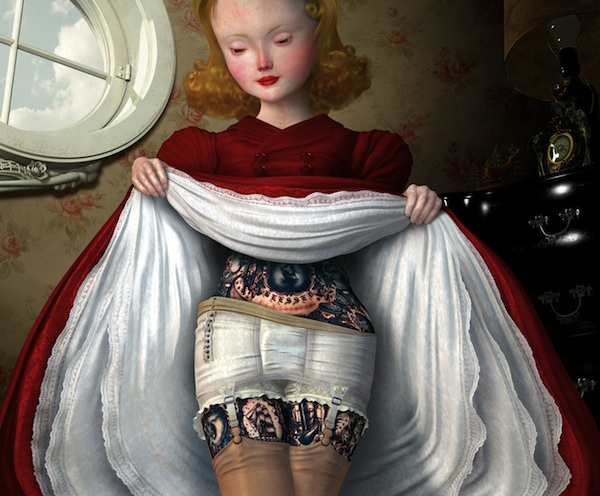
© Ray Caesar, Blessed, 2007 Courtesy of Jonathan Levine Gallery, NYC

© Ray Caesar, Blessed (Detail), 2007 Courtesy of Jonathan Levine Gallery, NYC
In his work Blessed, we see a girl with the scars of a caesarian section, a play on Caesar's name: It is a picture of "all the things I have to cut out of my life," says Casear. He likes the idea of drawing on skin - an ideal drawing surface he claims - though he would not tattoo himself. "I don't want to be ever not naked. You are always clothed if you have a tattoo," says Caesar.
KL: Sometimes we locate our sense of self outside of us, we externalize it, and forget to invert our senses to feel on the inside; Sometimes meditation is a way of becoming aware of our insides.
RC: During a panic attack your heart is going out of control. Recently, I had an inflammation of my heart, but I was calm as ever. Here I was actually having a heart attack, why was I calm?
With the 3D models, there are things that are not anatomically correct. They are not always girls under these clothes. Their appendages aren't always what they appear to be. They could be male or something completely different. I think we are all very different creatures. I always say this in some interviews: if you walk into a room and you turn out the light, then try to walk to where you want to go - and you reach your hand out - your hand sometimes feels as though it goes beyond your fingertips. You know the table is there before you get to it. Tentacles are coming out of your fingers and your hands. And all these places, fingertips, lips and genitals, our eyes, feel different in the dark. What are we really inside?
In Silent Partner she has taken her lover, and she has dismembered him. There is a head, his heart, his genitals, which are tied by a nice little blue ribbon - and his liver - I put them in a little cabinet with his glasses, with his pipe on top.
KL: Is that some kind of revenge?
RC: No, it's about every good man should know his place, and she's got them in the places that she wants them. And he's a silent partner. It's what I do to myself; I dismember myself. I am that person.
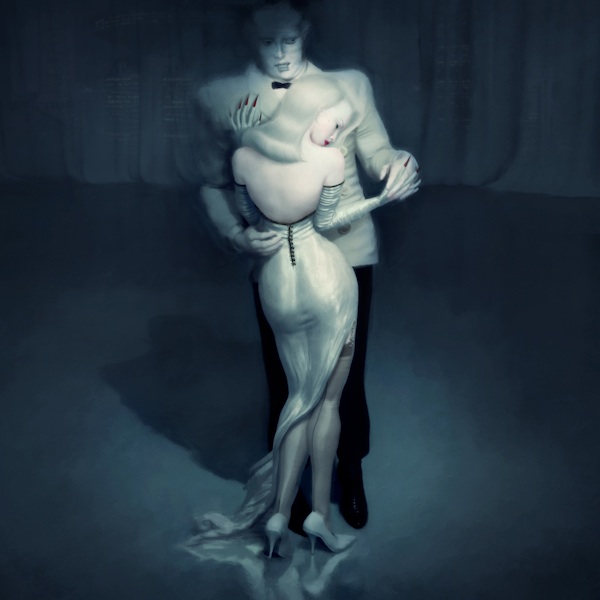
© Ray Caesar, Totentanz, 2010, Courtesy of Jonathan Levine Gallery, NYC
KL: Is that the same male character in Totentanz - a dance with death? Is that a personification of you?
RC: Yes he usually shows up dismembered, and parts of him are in the cupboard, he is a personification of the masculine side of me. I recently had a dance with death with the pericarditis, I caught an infection in my heart. The thing is, I don't know who death is in there, whether it is him or her - she could be dancing with a corpse. He is the male idiot that lives in me. I judge myself even more harshly. [It represents a] quality that I am not comfortable within myself. [The character] is at the whim of the women.
KL: Do you think brutality is just beneath the surface of sophistication in people, that we are inherently atavistic?
RC: It is in everyone, and everyone has a feminine and masculine side. I see it mostly in the masculine side of us. Not all men, but if you look at the world today, a lot of the problems are male created problems ...problems of men's fears.
We have to look at the way in which we bring up the masculine in us. To bring up males with more feminine qualities is to me an answer - but men find that too humiliating to even consider. This is another fear - the fear of humiliation. We have to be tough, but it is also our world and we have to find a place in it. I don't think we are fulfilling our place in it very well, to be honest - starting with myself first - it's not a judgment.
KL: The hunter or the hunted are qualities that could be present in both men and women.
RC: The hunter and the hunted are also survivors: It's the job of both the hunter and the prey to survive too. It's the balance of dark and light I try to put in my work, but I swing more towards the feminine side - these are sanctuaries of love, kindness and empathy.
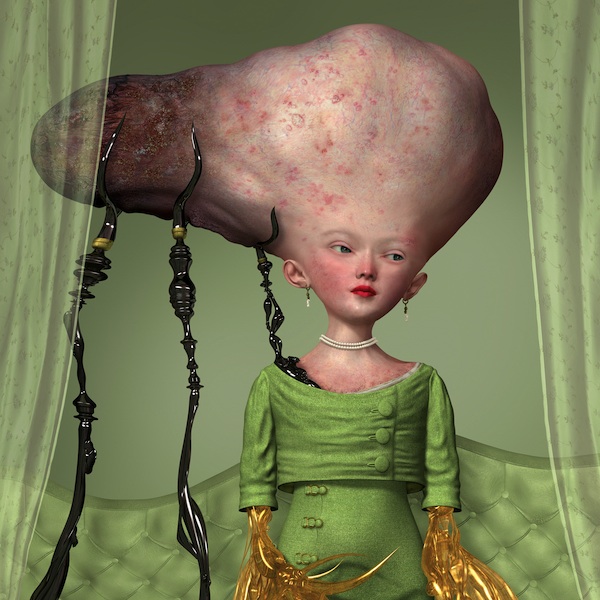
The Burden Of Her Memories 2007 © Ray Caesar, Courtesy of Jonathan Levine Gallery, NYC
[Caesar refers to paintings showing deformities, tentacular appendages here.] She wears her scars, not like medals but remembrances. Bruises, deformities...are a big part of my childhood. My father had certain physical deformities - childhood arthritis - and his feet were twisted and unrecognizable. There were times when his feet were in extreme pain, and I would take his shoes off and they were not what I would consider human feet.
KL: What are their universes like, the creatures you create?
RC: If you are kind and nice, you are perfectly safe. But it is a world where the cruel and kind are not tolerated too well. The favourite theme of mine is the huntress. That gives them the right to hunt back things that were taken from them. The children in the hospital were not given a life like you and I, their innocence was taken away. I make them hunters so they can hunt back that innocence.
KL: Some of them appear prepubescent and coming of age and some are eroticized. I think of Balthus' paintings of girls.
RC: I try to put a bit taboo, a bit of horror, love, and a bit of kindness, something sexual or asexual. A lot of them are angelic and there is some asexuality in that.

Precious, 2006 © Ray Caesar, Courtesy of Jonathan Levine Gallery, NYC
KL: In this picture, 'Precious,' she looks like she is masturbating with that doll.
RC: What she is doing is protecting her doll, and that doll is a representation of her, and it is upside down from her, like she is giving birth. Creating art is like giving birth. I had dolls when I was a child; one was Beatrice, and she was tall, and missing a leg, and up inside the cavity of her leg is where I kept all my toys and you can imagine what it was like walking into a room with this little boy with his arm up inside the cavity of her groin. These are things I like to play with. None of us know where sexuality begins.

Bubbles, 2007 © Ray Caesar, Courtesy of Jonathan Levine Gallery, NYC
'Bubbles' is all about puberty. I don't decide to put things in there, but they come to me... This is a window, and there are two towers outside, (I did them shortly after the World Trade Center went down) and she is blowing bubbles, which are about to burst - a symbol of innocence. The window was like a target. She is wearing all red, and on her lap, there is a little scenario with a woman bathing and a deer. It is the story of Actaeon - he got killed for seeing Diana bathe. She turned him into a stag, and her dogs hunted him down. Puberty is a change of life, a change of awareness - this girl's bubble is about to burst.
And the reference to the World Trade Center going down - well it changed everybody. If you talk about a subconscious, there is also a super-conscious, and we all went through puberty that day, and realized the world is a different place and always will be. So I play with the taboo, the sex, and innocence. I am hunting for a different flavour every time I make a picture...
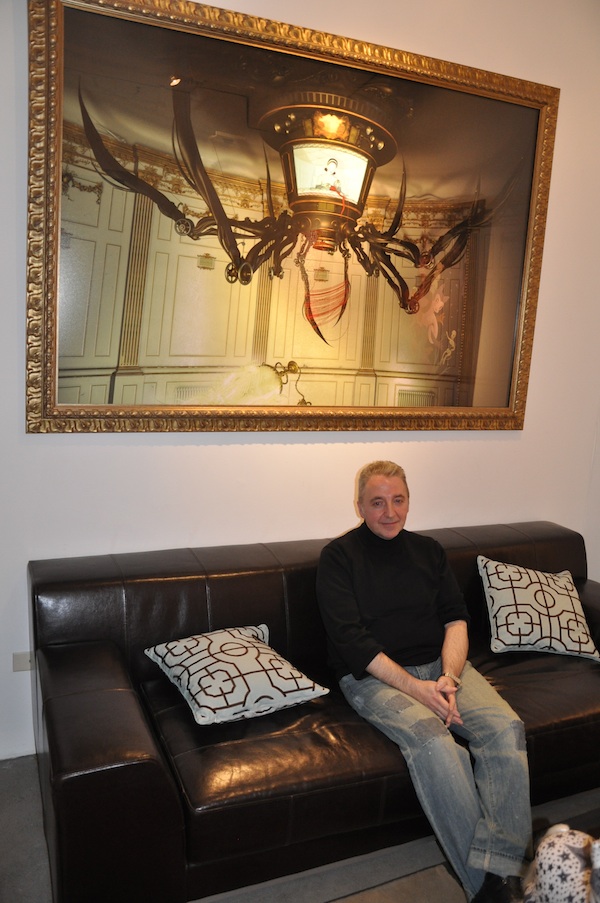
Ray Caesar, photo: Kisa Lala, 2011
Text: Kiša Lala
View: Spread ArtCulture
Ray Caesar A Gentle Kind of Cruelty, January 22, 2011 through February 19, 2011
Jonathan LeVine Gallery | 529 West 20th Street, 9th Floor | New York, NY 10011
